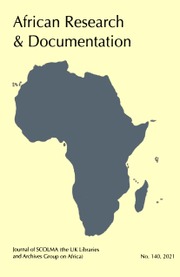No CrossRef data available.
Article contents
Images of Southern Ethiopia in the Archives of the Frobenius Institute
Published online by Cambridge University Press: 25 April 2022
Extract
The subject of this article is the unique and extensive visual documentation of Southern Ethiopia that is today preserved in the archives of the Frobenius Institute. The article will start by giving an overview on the research expeditions of Frobenius Institute members to southern Ethiopia in the years between 1934 and 1974. Then the methods and scope of the visual documentation created during these expeditions will be discussed, with a focus on two artists, who made the largest contribution to this exceptional material. Finally, I will describe the current efforts of the Frobenius Institute to make this visual documentation visible and freely accessible via online databases.
- Type
- Research Article
- Information
- Copyright
- Copyright © African Research & Documentation 2019


